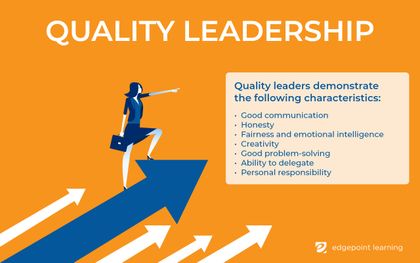11 Powerful Leadership Training Activities For Employees
Michael Hansen
🍿 5 min. read
Leadership training for employees can be engaging, thought-provoking, and truly productive when it comes to building teams. Here's how.
Few things in business are more guaranteed to produce groans than ice-breaking or team-building activities. Why? Because most of these feel forced and inauthentic, placing employees in uncomfortable situations with strangers and forcing them to make the best of it. What happens is that people are on their best behavior, ice remains firmly in place, and your teams are no stronger than before. But it doesn’t have to be that way. Leadership training for employees can be engaging, thought-provoking, and truly productive when it comes to building teams. Here's how.
Why to have leadership training for employees
Maybe you have focused on leadership training for your management teams alone, or maybe your new hires came fully equipped with comprehensive management skills that didn’t require new training. But have you considered leadership building activities for all employees?
Consider the following benefits.
Leadership training promotes more engagement
Especially when team exercises bring together employees who work remotely or often on their own, leadership training activities can better engage employees in the mission of the company no matter where they are.
Organizational leadership activities inspire innovation
A well-designed set of leadership building activities for employees can promote learning and inspire innovation, particularly in the case of problem-solving.
Leadership building activities can promote learning and inspire innovation.
Leadership training activities for employees promote advancement from within
This type of training identifies potential in employees that may have labored in relative obscurity otherwise.
What leadership training activities for employees actually work?
Each company might have a different answer to this complex question, but in general, quality leaders demonstrate the following characteristics:
- Good communication
- Honesty
- Fairness and emotional intelligence
- Creativity
- Good problem-solving
- Ability to delegate
- Personal responsibility
Here are 11 suggestions for engaging and thoughtful leadership building activities.

1. Simple icebreaking questions
For the number of employees you have, write a list of questions that are light-hearted but potentially revealing. Have employees randomly pick a number and answer the question that corresponds. Examples include:
- What’s the wallpaper on your cellphone?
- If you could have an unlimited supply of one thing for the rest of your life, what would it be?
- Do you have scars? Tell the story of one of them.
- What is the most out-of-character thing you’ve done?
2. Thirty seconds left
Following up on the icebreaking questions, have employees consider the best experiences of their life. Have them reflect and then select one before refining it down to the best 30 seconds of that experience. Give them 30 seconds to talk about that moment.
This leadership training activity helps build clear communication and promotes emotional intelligence – two key qualities of good leaders.
3. Back-to-back drawing
Split into pairs and have them sit back-to-back. Give one person paper and pen; the other gets an object. The person with the object describes it without naming it (you can ban other identifying phrases, too), and the other person draws it.
This works on communication – always crucial and sometimes challenging to develop.
4. Office trivia
This activity tests knowledge specific to your office.
You could divide participants by the teams they regularly work in, or allow employees to form their own teams.
5. Qualities of a leader
Break employees into teams and have them share leaders they admire (in any industry). Take notes on the characteristics that these leaders share, then give employees time and space to reflect on the characteristics they share with those leaders before identifying skills they would like to develop.
Bonus: Use employee notes on skills they would like to develop to design your own training opportunities.
6. Desert island
Employees come together to select five items to bring to a desert island. The group has to come to consensus, and one person presents the agreed-upon list.
7. Moon shot
You can start this activity in one of two ways: have employees brainstorm crazy, innovative ideas for your company, or bring two or three of your own to the table.
Working in teams, employees begin to develop a plan to implement the idea. Think really big here.
8. Explore virtual reality (VR)
In everything from surgical training to car design to accident damage assessment, virtual reality is a leadership training activity that helps not only strengthen current leadership but also identify and develop potential leaders among your employees. For example, Wal-Mart recently used VR technology to identify new leaders within their stores.
What happens in the headset will be different depending on your industry, but VR can build a variety of leadership skills (and assess training progress at the same time).
9. Use augmented reality (AR)
Remember Pokémon Go? When this augmented reality (AR) app came out in 2016 it was hard to avoid people stopped in the middle of the sidewalk, capturing a Pokémon with their mobile device.
AR leadership exercises could include things like a competition for teams to locate defined targets (e.g., examples of new codes in action or a properly assembled piece of equipment). AR uses GPS locations, just like geofencing does, so whenever the whole team is together the target can send a push notification to their devices.
10. Gamification
Just like gamers the world over play World of Warcraft together online, so, too, can employees participate in leadership training activities that have them work together for a common goal.
Gamification can be used to strengthen skills of individual employees, too. Think navigating a customer complaint online (solo skill) versus dealing with the recall of an entire product line (team skill, with every department from public relations to the production team online).
11. Scavenger hunts
This one takes some planning but can be a great way to promote teamwork (and help employees get to know each other). Set up landmarks to visit and items to “gather” (real or virtually), and offer prizes upon completion.
Your scavenger hunt need not be related to your industry. This is really a way for teams to work together and get to know one another in a relaxed atmosphere.
Suggestions for success
Another great way to identify powerful leadership training activities for employees is to ask your employees! Chances are good they have a few suggestions for you.
For all trainings, both IRL and online, following a few simple guidelines can help.
- Fit the training to the goal: It’s hard to build a team if your activities are designed to be completed alone
- Allow time for reflection: What worked? What didn’t? How would you change your participation?
- Ask for suggestions for make the process better
- Observe: Watch groups as they work
- Be consistent: Make these activities a regular part of employee training
- Provide refreshments: Simply put, good food is always a good training incentive
EdgePoint Learning can help you design engaging leadership training activities for employees (that won’t be met with eyerolls!). Get in touch to get started today.
